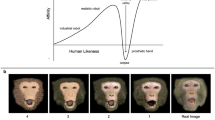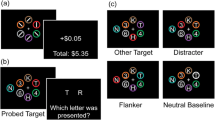Abstract
The behavioral functions of rewards comprise the induction of learning and approach behavior. Rewards are not only related to vegetative states of hunger, thirst and reproduction but may also consist of visual stimuli. The present experiment tested the reward potential of different types of still and moving pictures in three operant tasks involving key press, touch of computer monitor and choice behavior in a laboratory environment. We found that all tested visual stimuli induced approach behavior in all three tasks, and that action movies sustained consistently higher rates of responding compared to changing still pictures, which were more effective than constant still pictures. These results demonstrate that visual stimuli can serve as positive reinforcers for operant reactions of animals in controlled laboratory settings. In particular, the coherently animated visual stimuli of movies have considerable reward potential. These observations would allow similar forms of visual rewards to be used for neurophysiological investigations of mechanisms related to non-vegetative rewards.






Similar content being viewed by others
References
Andrews MW, Rosenblum LA (1993) Live-social-video reward maintains joystick task performance in bonnet macaques. Percept Mot Skills 77:755–763
Andrews MW, Rosenblum LA (2002) Response patterns of bonnet macaques following up to 75 weeks of continuous access to social-video and food rewards. Am J Primatol 57:213–218
Brannon EM, Andrews MW, Rosenblum LA (2004) Effectiveness of video of conspecifics as a reward for socially housed bonnet macaques (Macaca radiata). Percept Mot Skills 98:849–858
Butler RA (1954) Incentive conditions which influence visual exploration. J exp Psychol 48:19–23
Butler RA (1961) The responsiveness of rhesus monkeys to motion pictures. J genet Psychol 98:239–245
Butler RA, Woolpy JH (1963) Visual attention in the rhesus monkey. J comp physiol Psychol 56:324–328
Deaner RO, Khera AV, Platt ML (2005) Monkeys pay per view: adaptive valuation of social images by rhesus monkeys. Curr Biol 15:543–548
Fujita K (1987) Species recognition by five macaque monkeys. Primates 28:353–366
Fujita K, Matzusawa T (1986) A new procedure to study the perceptual world of animals with sensory reinforcement: recognition of humans by a chimpanzee. Primates 27:283–291
Humphrey NK (1972) “Interest” and “pleasure”: Two determinants of a monkey’s visual preferences. Perception 1:395–416
Kish GB (1966) Studies of sensory reinforcement. In: Honig WK (ed) Operant Behavior. Appleton-Century-Crofts, New York, pp 109–159
Rnic A (1977) Male versus female siamese fighting fish as reinforcing stimuli for conspecific males in single- and two-choice operant situations. Learn Motiv 8:263–274
Swartz KB, Rosenblum LA (1980) Operant responding by bonnet macaques for colour videotape recordings of social stimuli. Anim Learn Behav 8:311–321
Thompson TI (1963) Visual reinforcement in siamese fighting fish. Science 141:55–57
Thompson TI (1964) Visual reinforcement in fighting cocks. J Exp Anal Behav 7:45–49
Washburn DA, Hopkins WD (1994) Videotape- versus pellet-reward preferences in joystick tasks by macaques. Percept Mot Skills 78:48–50
Washburn DA, Hopkins WD, Rumbaugh DM (1991) Perceived control in rhesus monkeys (Macaca mulatta): enhanced video-task performance. J Exp Psychol Anim Behav Process 17:123–129
Acknowledgements
We thank F. Tinguely for help with testing the animals, and B. Aebischer, J. Corpataux, A. Gaillard and B. Morandi for expert technical assistance. The study was supported by the Wellcome Trust and Swiss NSF.
Author information
Authors and Affiliations
Corresponding author
Rights and permissions
About this article
Cite this article
Blatter, K., Schultz, W. Rewarding properties of visual stimuli. Exp Brain Res 168, 541–546 (2006). https://doi.org/10.1007/s00221-005-0114-y
Received:
Accepted:
Published:
Issue Date:
DOI: https://doi.org/10.1007/s00221-005-0114-y




